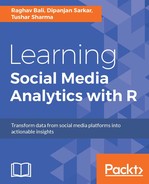Through the chapters of this book, we have travelled a journey encompassing different social networks, covering varied aspects of our digital lives, and we've utilized the tools from the data science toolbox to understand them better. This penultimate chapter is about a social network which has stood the test of time and is still widely used: Flickr. Once one of the most popular kids on the block, it still stands strong with a huge user base and some interesting features. In this chapter, we will learn about this visually driven social network through the lens of a data scientist. We will leverage what we learned from previous chapters to first understand the platform followed by ways of getting data from it, and then discuss different use cases. We will also touch upon some photography basics on the way to utilize domain knowledge for better results. Let's get start; say cheese!
In the age of ephemeral messaging and disappearing photos, square instant clicks with amazing filters and AI rendered art pieces from phone cameras, platforms that come to mind are Snapchat, Instagram, Prisma, and so on. While these young platforms hog the limelight and have become mainstream, Flickr stands at the other extreme of this instant spectrum.
Flickr started in 2004 as a side project, but it quickly became a mammoth project loved and used by millions of users across the world. It has gone through multiple iterations of interface changes, feature enhancements, and owners (the last one being Yahoo! Inc.); and yet it has stayed consistent with its theme as a photo sharing platform. It caters to, not only the instant generation, but also amateur and professional photographers to share, discuss, and appreciate photography from across the world.
Flickr is one of the oldest social networks to cater to photography enthusiasts, and it has features related to uploading, commenting, liking, exploring and so on that are now common across all major social networks. Apart from these, it provides copyright related features, and more, which are extensively used and liked by professional photographers from across the world. Yet, there has to be something which makes Flickr interesting as a platform.
Since its inception, Flickr has been at the forefront of community build up and using its vast data assets to understand and improve user behavior, computer vision, object identification, and so on. With over 100 million+ active users, an average of a million photo uploads every day, and a total of 10 billion photos, Flickr has formidable data assets to do and assist research in various fields including data science and machine learning.
Flickr has another trick up its sleeve and it's called the interestingness feature. It is a proprietary algorithm which looks at many attributes/parameters of each photograph uploaded onto the site to select and present them to users when they log in to the platform on the Explore page. The exact details of this algorithm have been kept secret, though researchers and photographers across the world have tried to understand and uncover its mysteries to find interesting photos. As part of this chapter, we will also try to make use of this feature and uncover interesting insights as well.
Note
More details on interestingness: https://www.flickr.com/explore/interesting/. Flickr also upped the ante with another take on interestingness by introducing Flickr Pandas: check it out here: http://code.flickr.net/2009/03/03/panda-tuesday-the-history-of-the-panda-new-apis-explore-and-you/
